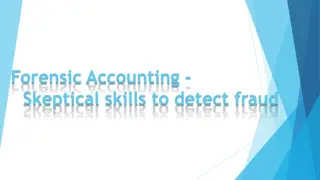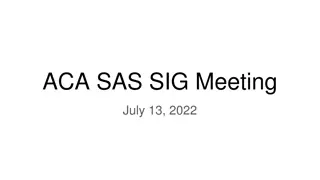Understanding SAS 99 and Fraud Consideration in Financial Audits
This presentation delves into SAS 99, highlighting the importance of considering fraud in financial statement audits. It explains the impact of SAS 99 on auditors, emphasizes management's role in preventing and detecting fraud, and discusses the Fraud Triangle and types of fraud addressed by SAS 99. Professional skepticism and the responsibilities outlined for management are also covered.
Download Presentation

Please find below an Image/Link to download the presentation.
The content on the website is provided AS IS for your information and personal use only. It may not be sold, licensed, or shared on other websites without obtaining consent from the author. Download presentation by click this link. If you encounter any issues during the download, it is possible that the publisher has removed the file from their server.
E N D
Presentation Transcript
SAS 99 Consideration of Fraud in a Financial Statement Audit
Provide CPAs with Clarified and Focused Auditing Guidance on Fraud Re-emphasize the role of entity management and boards in preventing and detecting fraud
This Presentation SAS 99 is applicable to Financial Statement Audit Its approach is valuable for other audits Overview of SAS 99
SAS 99 Impact on the Auditor No change in the auditor s responsibility to detect material fraud in financial statement audits No change in the auditor s required communication of evidence of fraud Significant changes in required auditing procedures and documentation in a financial statement audit
The SAS Says Its management s responsibility: Setting the proper tone Creating and maintaining a culture of honesty and ethics Establishing appropriate controls
The Fraud Triangle Motive Rationalizatio n Opportunity
The Two Types of SAS 99 Fraud Misstatements arising from fraudulent financial reporting Intentional misrepresentation in or omission of material events, transactions or other information Intentional misapplication of GAAP Falsification or manipulation of accounting records or documents Misstatement arising from misappropriation of assets Theft that causes the financial statements to not be fairly presented in all material respects
Exercising Professional Skepticism Defined as an attitude that includes a questioning mind and a critical assessment of audit evidence Mindset that recognizes that any material misstatement could be the result of fraud Requires on-going questioning of whether evidence suggests a possible fraud
On-G Overview of the Fraud Audit Process Brainstorming Obtaining Risk Info Documenting On-Going Process Throughout The Audit Communicating Identifying Risks Evaluating Evidence Assessing Risks Responding to Risks
Brainstorming Brainstorming Obtaining Risk Info Documenting Identifying Risks Communicating Evaluating Evidence Assessing Risks Responding to Risks
Brainstorming Audit planning How and where the financial statements might be susceptible to fraud or what s here to steal Emphasize importance of proper state of mind (professional skepticism) during the audit Include risk of management override of controls Should continue throughout the audit
Brainstorming Discuss incentives/pressures and opportunities Why would management want to falsify its f/s? Political promises such as cutting spending Budgetary pressures consider the climate
Brainstorming What would someone want to steal, how would they do it What are the opportunity assets (easily transferred, valuable, desirable, money) How could someone convert personal expenses to public How could the politician use the office to enhance political career, fulfill campaign promises
Brainstorming What is the culture of the organization? Is it a culture of Trust, Hope, and Love Consider opportunities for fraud Management style (open or closed) Recording and reporting Segregation of duties, controls, policies Consider effectiveness of oversight committee Audit committee Board
Brainstorming What might be the results of your brainstorming meeting? Closed management style Elected official 20+ years at the helm Political machine Employees loyal to leader Not a great amount of incentive/pressure to falsify the f/s Lots of opportunity assets Planes, dozers, building equipment, nurseries, money Business expenses that mirror personal Air Travel, home building supplies
Brainstorming Brainstorming results: CASE STUDY: Los Angeles Dept. of Agriculture A way around the bid law Lots of contracts handed out to the public Culture: Recent fraud audit hampered by mgmt. Recent audit response indicated lack of appreciation for audit process Recording/Reporting process CFO is related to the leader CFO heavily involved in campaign
Brainstorming Continue the process throughout the audit Emphasize professional skepticism Continuously apply critical thinking Could this transaction be fraud Does this document really tell the true story of the transaction
Obtaining Risk Information Brainstorming Obtaining Risk Info Documenting Identifying Risks Communicating Evaluating Evidence Assessing Risks Responding to Risks
Obtaining Risk Information Inquiries of management and others about fraud risk and their response to the risk Direct knowledge Allegations of fraud by others Management s understanding of the risks of fraud and where it is most likely to exist Programs and controls established to mitigate the specific risks of fraud identified How management communicates ethics to employees
L.A. Dept. of Agriculture: Obtaining Risk Information In 1988 the IG questioned the Commissioners use of dept. aircraft for personal use Dept. pilot told us he had to fly the Commissioner s wife to a dance recital Analytical review of food storage contracts indicated excessive payments $3.7-$4.3million Contractor informed us that he had to give $$$ to the Commissioner*
L.A. Dept. of Agriculture: Obtaining Risk Information Terminated employees filed for unemployment Disqualified Administrative law judge found: Her performance suffered only due to the fact that she would frequently be called away so that she could run personal errands for the commissioner Analytical review of exec. Secretary salaries = 94% higher than other agencies
Identifying Fraud Risks Brainstorming Obtaining Risk Info Documenting Identifying Risks Communicating Evaluating Evidence Assessing Risks Responding to Risks
Identifying Fraud Risks Professionals judgment required Think in terms of incentive/pressures, opportunities, and rationalization Standard has excellent lists Risk attributes to consider: Type of risk: reporting or misappropriation Significance of the risk; could it be material Likelihood of the risk; what s the likelihood it result in fraud Always consider management s ability to override controls apart from specifically identified risks
L.A. Dept. of Agriculture: Identifying Risk Risk of kickbacks Incentive: Hangs with big boys and not so big salary Opportunity: 100% control and ability to override any control Would probably result in excess contract costs Likely not material Information specific enough, sounds credible
L.A. Dept. of Agriculture: Identifying Risk Risk of improper use of aircraft: Incentive: Travels, family spread across L.A., farm 200 miles away, hunting camp 180 miles away Opportunity: Total control, he s also a pilot Rationalization: Told the IG that it allowed him to be the commissioner more Highly likely, probably small dollars, big message to staff and not a good one
Assessing Fraud Risks Brainstorming Obtaining Risk Info Documenting Identifying Risks Communicating Evaluating Evidence Assessing Risks Responding to Risks
Assessing Fraud Risks Professional judgment what do I have when I consider what I have obtained Assessment should take into account an evaluation of the entity s programs and controls that address fraud risks Tone at the top Does the entity train in ethics and values
L.A. Dept. of Agriculture: Assessing Risk Information indicating risk of Abuse of equipment airplane Abuse of power bid manipulation Abuse of tax dollars excessive salaries Abuse of employees personal errands
Responding to Fraud Risks Brainstorming Obtaining Risk Info Documenting Identifying Risks Communicating Evaluating Evidence Assessing Risks Responding to Risks
Responding to Fraud Risks There are three ways to respond: Alter the overall way the audit is conducted Change the nature, timing, or extent of audit procedures Perform procedures to address the risks related to management s ability to override controls
L.A. Dept. of Agriculture Responding to Risk Altered overall way audit conducted Risk of excessive salaries extensive interviews of current and prior employees Risk of improper use of aircraft interviews of pilots, review flight logs, compare flight times to reasonable flight plans, personal calendars Risk of bid manipulation interview bidders, review bids, compare to other states, review books of specific bidders, review old court testimony
Other Responses If risk indicates payroll fraud Observe activities Examine electronic gate/door activity Add unpredictability to procedures Use computer aided techniques Compare employment dates to check/service dates Changes to the pay code or other fields Unusual changes (negative retirement?)
Evaluating Audit Evidence for Fraud Brainstorming Obtaining Risk Info Documenting Identifying Risks Communicating Evaluating Evidence Assessing Risks Responding to Risks
Evaluating Audit Evidence for Fraud Evidence gathered during audit my indicate additional risks Be alert for: Discrepancies in the accounting records such as: Receivable balance doesn t agree to customer accounts Cash collected regularly but not deposited regularly Cash/check composition of deposits Conflicting or missing evidential matter Maybe they didn t keep the record of the bad transaction Problematic or unusual relationships between the auditor and client
Evaluating Audit Evidence Fraud is intentional acts Errors unintentional Prove the elements of the fraud Theft: Taking, belongs to another, w/o their knowledge, intent to permanently deprive Public payroll fraud: payments for services not received or grossly inadequate for compensation
L.A. Dept. of Agriculture: Evaluating the Evidence Use of aircraft: Belongs to the state Misrepresented as business flights Didn t reimburse for majority, so intent to permanently deprive state of $$$ Excessive Salaries Commissioner personally appointed 14 individual Paid them $70,000+ for jobs normally paid half that None performed duties for which they were paid All worked his campaign 5 performed personal work including building his children s homes
Communicating Fraud Evidence Brainstorming Obtaining Risk Info Documenting Identifying Risks Communicating Evaluating Evidence Assessing Risks Responding to Risks
Communicating Fraud Evidence Whenever evidence of fraud is found, it should be brought to the attention of the appropriate level of management Even if the matter is inconsequential Report directly to the audit committee when: Fraud causes a material misstatement Fraud involves senior management Reach an advance understanding with the audit committee about fraud involving lower-level employees
Documenting Fraud Considerations Brainstorming Obtaining Risk Info Documenting Identifying Risks Communicating Evaluating Evidence Assessing Risks Responding to Risks
Documenting Fraud Considerations Brainstorming sessions Procedures performed to obtain information needed to identify and assess fraud risks Specific fraud risks identified and descriptions of how you responded to those risks























